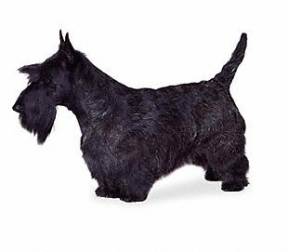Height: 10 inches
Weight: 18-22 lbs.
Life Span: 12-14 yrs.
Breed Group: Terriers
Overview
Scotties are self-assured, spunky, fearless, and independent. They require
early socialization and ongoing obedience training.
They are devoted to their families and get along with children if exposed
to them at an early age. Some, however, can be snappish and irritable at
times, so they may not be the best choice for a family with young children.
They may be aggressive with other animals, including cats and dogs, if not
raised with them.
They bark a lot and are natural watchdogs. Scotties can live anywhere as
long as they are given daily exercise. They must be limited to safe, enclosed
areas when off-leash, as they are likely to chase small animals.
Appearance
The Scottie's eyebrows are long, its beard ample. Its weather-resistant
coat is hard and wiry with a soft and dense undercoat. The coat color is
black, sandy, wheaten, steel or iron gray, brindled or grizzled. A small
amount of white may appear on the chest and chin.
Grooming & Exercise Needs
Scotties need to be brushed one to two times a week and trimmed every three
months. They need several brisk walks and daily playtime with their owners.
Origins
This compact, sturdily built dog originated in the 19th century in the Scottish
Highlands, where it was used to hunt vermin.
Breed-related health concerns: von Willebrand's disease (a common
disorder that causes excessive bleeding during or after surgery), craniomandibular
osteopathy (a bone disease causing excessive growth of head bones in young
dogs), allergies, lymphoma, Scottie cramp (a disorder appearing at around
one year characterized by muscle stiffness when the dog is excited), elbow
dysplasia, intervertebral disc protrusion.
Reference: AKC - American Kennel Club |

